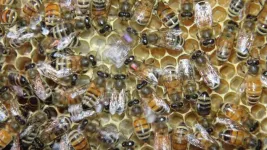(Press-News.org) Researchers from Children’s Hospital of Philadelphia (CHOP), Florida State University (FSU), and the University of California, Los Angeles (UCLA) have demonstrated that starting intervention coaching parents of autistic toddlers as early as 18 months leads to better gains in language, social communication, and daily living skills.
Their findings were recently published in the journal Autism.
While prior studies provided strong evidence for the benefits of early intervention in autism, many are correlation studies rather than randomized controlled studies that can provide more conclusive results. Additionally, prior research has not demonstrated an ideal age at which to begin interventions.
“Many of us in the autism community say earlier is better, but we actually do not have enough high-quality evidence for that, so a randomized controlled trial like this one helps address that issue,” said lead author Whitney Guthrie, PhD, a clinical psychologist with the Department of Child and Adolescent Psychiatry and Behavioral Sciences and the Division of Developmental and Behavioral Pediatrics and researcher at CHOP’s Center for Autism Research.
Researchers used the Early Social Interaction (ESI) model, a parent-implemented intervention for toddlers diagnosed with autism that provides a framework to support a child’s development in social communication and active engagement. It also is a framework for parents as they receive both group education and individualized coaching to incorporate evidence-based strategies into everyday activities in the family’s natural environments.
In this study, families received both group and individual conditions but were randomized as to whether the Individual-ESI intervention coaching began when the toddlers were 18 months old or 27 months old. A total of 82 toddlers and their parents participated in the study, conducted at Florida State University and the University of Michigan.
The study found that children who received individualized ESI coaching earlier showed greater gains in use and understanding of language, social use of communication skills, and self-help skills. Additionally, the findings were specific to the intensive and individualized parent-coaching model, compared with the group-education treatment.
“This study provides research findings that show starting just nine months earlier, at 18 months versus 27 months, makes a difference in the child’s progress,” said Amy Wetherby, PhD, director of the Autism Institute at Florida State University. “And that makes sense because this is during a period in which a child’s brain is developing the most rapidly, in the first two years of life. That doesn’t mean they won’t continue to learn later, but by providing these interventions even earlier, they have the greatest chance of having the most impact.”
“This program is also not something that is likely to cause harm, and it could help many children, with or without autism,” UCLA Professor Catherine Lord, PhD, said. “The intent is to support parents and other caregivers in their everyday interactions, not to replace other possible sources of intervention, including preschool programs and direct therapies.”
The research team included Guthrie and co-principal investigators Wetherby and Lord. Guthrie worked with Lord during her undergraduate career at Michigan, then worked with Wetherby during her doctoral program in clinical psychology at FSU. The findings were part of Guthrie’s ambitious doctoral dissertation.
This study highlights the importance of the recommendation of the American Academy of Pediatrics that all children are first screened for autism at 18 months, which is critical to get started earlier with intervention, Wetherby said.
Lord hopes the study results “will stimulate discussions among governmental agencies about how to get children into services faster, perhaps by not waiting for formal diagnoses but requiring an eventual diagnosis at some point, and also by providing more and better reimbursed diagnostic services.”
Lord also wants frontline workers who might be the first to see the children —like pediatricians, primary care physicians, speech-language pathologists and occupational therapists— to be able to admit children into programs.
Guthrie said that while it is important to expand future research to include more children from a wider and more diverse community, the results of this study provide measurable evidence supporting earlier intervention.
“Our findings underscore the importance of a swift referral for evaluation if a child screens positive for autism, or there is any professional or caregiver concern for autism,” Guthrie said. “We want to make sure that toddlers don’t miss this important window for earlier intervention.”
This study was supported by the National Institute of Mental Health and the Eunice Kennedy Shriver National Institute of Child Health and Human Development. This research was also supported in part by the funding from Autism Speaks and the Simons Foundation.
###
END
Researchers find earlier intervention leads to greater improvements in young children on the autism spectrum
2023-04-13
ELSE PRESS RELEASES FROM THIS DATE:
Private lands stalling Brazil’s conservation efforts
2023-04-13
As Brazil seeks ways to protect its crucial Amazon Forest, a new study shows that excusing private landowners from conserving their precious land has come at a steep cost to global sustainability.
In this week’s Nature Communications Earth & Environment, scientists at Michigan State University’s Center for Systems Integration and Sustainability (MSU-CSIS) as well as Brazil and the UK found that since 2012 more than half of the deforestation in the Brazilian Amazon has taken place on designated private conservation areas within rural private properties. However, ...
Hairs that help fish feel–and humans hear
2023-04-13
CLEVELAND–By discovering how zebrafish use their hair cells to detect distant movement, a team of Case Western Reserve scientists may have found a path to help explain human hearing loss.
Even though the tiny water creatures and humans would appear to have nothing in common, the structure and function of the hair cells on zebrafish skin are nearly identical to cochlear hair cells found in the human inner ear.
In addition, both the fish and human cell receptors have a type of protein known as an “ion channel,” which converts the waves that the cells detect into electrical impulses that carry useful information.
However, in humans, ...
Wildfires and animal biodiversity
2023-04-13
Wildfires. Many see them as purely destructive forces, disasters that blaze through a landscape, charring everything in their paths. But a study published in the journal Ecology Letters reminds us that wildfires are also generative forces, spurring biodiversity in their wakes.
“There’s a fair amount of biodiversity research on fire and plants,” said Max Moritz, a wildfire specialist with UC CooperativeExtension who is based at UC Santa Barbara’s Bren School of Environmental Science & Management, and is the study’s lead author. Research has shown that in ecosystems where fire is a natural and regular occurrence, there ...
New look at climate data shows substantially wetter rain and snow days ahead
2023-04-13
A key source of information underpinning the upcoming National Climate Assessment suggests that heavy precipitation days historically experienced once in a century by Americans could in the future be experienced on several occasions in a lifetime.
Scientists at Scripps Institution of Oceanography at UC San Diego and the Department of Energy’s Lawrence Berkeley National Laboratory (Berkeley Lab) report that extremely intense days of rain or snow will be more frequent by the end of this century than previously thought ...
Manchester graphene spin-out signs $1billion game-changing deal to help tackle global sustainability challenges
2023-04-13
A spin-out company from the graphene innovation ecosystem at The University of Manchester has formed an international partnership that will spearhead an unprecedented scale-up of graphene-based technologies intended “to make a substantial impact on global CO2 emissions”.
UK-based Graphene Innovations Manchester Ltd (GIM), founded by University of Mancheser graduate Dr Vivek Koncherry, has signed a Memorandum of Understanding (MoU) with Quazar Investment Company to create a new company in the UAE. Graphene innovation has "
This agreement - ...
Will ChatGPT replace computational materials scientists?
2023-04-13
“ChatGPT is a very impressive tool,” said paper author Zijian Hong, professor at the School of Materials Science and Engineering, Zhejiang University, China. “As a computational materials scientist, I’m always eager to embrace new tools, in particular, new tools in computer science and AI. Since the born of the new ChatGPT, I’m just wondering whether such a tool can assist us in computational materials science”
Hong explained that for a computational materials task, there are three main steps: building a model or a structure, writing ...
Towards a deeper understanding of turbulence in elastoviscoplastic fluids
2023-04-13
Three-dimensional simulations shed light on how energy dissipates within non-Newtonian fluids (fluids in which viscosity depend on the shear rate.) The result is valuable in the context of disaster forecast and management or industrial production.
Elastoviscoplastic (EVP) fluids like mud, concrete, and lava are a type of non-Newtonian fluid that exhibit both solid and fluid-like behavior depending on the forces they are subjected to (i.e., applied stress). Their flow behavior is more complex than that of Newtonian fluids, such as water and air, which have a constant viscosity. In a recent study, researchers ...
Stop signals reduce dopamine levels and dancing in honeybees
2023-04-13
Researchers from the Xishuangbanna Tropical Botanical Garden (XTBG) of the Chinese Academy of Sciences and the University of California San Diego have revealed that receiving an inhibitory signal (stop signal) associated with negative food conditions can decrease brain dopamine levels in dancing honeybees.
The study was published in Current Biology on April 13.
Dopamine is known as the feel-good neurotransmitter—a chemical that ferries information between neurons. In multiple animals, dopamine is involved in arousal, cognition, and sensitivity to stimuli. It is also associated with seeking and wanting behavior, particularly ...
Health care–associated infections among hospitalized patients with vs without COVID-19
2023-04-13
About The Study: In this analysis of more than 5 million hospitalizations between 2020 and 2022, health care–associated infection (HAI) occurrence among inpatients without COVID-19 was similar to that during 2019 despite additional pressures for infection control and health care professionals. The findings suggest that patients with COVID-19 may be more susceptible to HAIs and may require additional prevention measures.
Authors: Kenneth E. Sands, M.D., M.P.H., of HCA Healthcare in Nashville, is the corresponding author.
To access the embargoed study: Visit our For The Media website at this link https://media.jamanetwork.com/
(doi:10.1001/jamanetworkopen.2023.8059)
Editor’s ...
Risk of new retinal vascular occlusion after mRNA COVID-19 vaccination
2023-04-13
About The Study: The findings of this study including more than 3 million patients receiving the mRNA COVID-19 vaccine suggest that retinal vascular occlusion (RVO) diagnosed acutely after vaccination occurs extremely rarely at rates similar to those of two different historically used vaccinations, the influenza and tetanus, diphtheria, pertussis (Tdap) vaccines. No evidence suggesting an association between the mRNA COVID-19 vaccination and newly diagnosed RVO was found.
Authors: Rishi P. Singh, M.D., of ...






